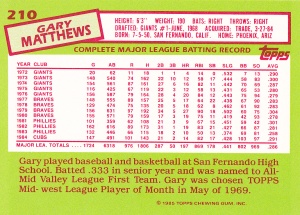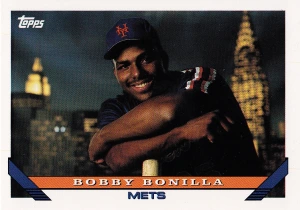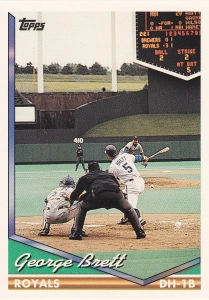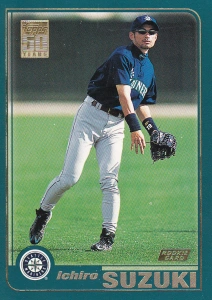 An overview of the 1985 Topps set:
An overview of the 1985 Topps set:
- 792 cards in the set – the same since 1982.
- Subsets: Record Breakers (1-7), Father-Son (131-144), #1 Draft Picks (271-281), Team USA (389-404), All-Stars (701-722), and Managers (26 cards throughout). Father-Son depicts current Major League players with their fathers who also played MLB – Yogi and Dale Berra may be the most notable. #1 Picks shows former first overall picks still active in the Majors, while Team USA shows college players from the 1984 US Olympic Team which won the silver medal. The Team USA set has the only true Mark McGwire RC, and it only includes players whose college eligibility was up. Notably, Barry Larkin and Will Clark were on the ’84 USO team, however were not included in the set. These three new subsets replace the various 1984 are “Leaders” subsets – Team, League, and Active.
- Set Design: Topps made some design changes in the current year – the dual picture design from ’83 and ’84 were scrapped for a larger main photo. The front has a white border featuring the Topps logo in the top left-hand corner. The team name with team colors is featured in a diagonal box across the bottom next to a circle around the team logo on the right. The player name and position is shown just below the team information. The green card backs features the player name and card number in the upper left-hand corner, player bio and stats from each season and career totals. If there’s room, player-specific information and an upside-down trivia question are shown at the bottom.
- Packs: Cards were issued in 15 card wax packs (35¢ SRP) that came 36 packs per box and 20 per case. Also available in 49-card rack packs (99¢ SRP), 42-card grocery rack packs, and 28 card cello packs (59¢ SRP).
- Rookies: The most significant rookies are the aforementioned McGwire, Roger Clemens, Kirby Puckett and Dwight Gooden. Eric Davis, Brett Saberhagen, and Orel Hershiser also had a rookie card in this set. Gooden and Saberhagen was in the ’84 Topps Traded and Fleer Update sets, while Clemens and Puckett had XRCs in the Update set only. McGwire, Davis and Hershiser are true RC’s.
- Hall of Fame: There are 45 Hall of Famers in this set, down 4 from the year before. Bench, Yaz and Gaylord Perry retired following the 1983 season and only had subset cards in the ’84 set. Jim Palmer and Fergie Jenkins were released early in the 1984 season (Jenkins during spring training), and subsequently retired. Frank Robinson was fired as the Giants manager in the middle of the ’84 season. The Yankees hired Yogi Berra for what would be a controversial stint as manager, and Kirby Puckett’s first card was in this set. As of now the Puckett card is currently the latest Rookie Card of a player inducted in the Hall (since passed by a number of guys). This made sense when I thought about it; Puckett had a short career, and all the recent inductees outside of Rickey Henderson are guys who had to wait some time (Dawson, Rice, Sutter, Gossage). So this number will continue to drop from here forward, after peaking at 51 HOF-ers in 1983.
- Harold Baines, Bert Blyleven, Wade Boggs, George Brett, Rod Carew, Steve Carlton, Gary Carter, Andre Dawson, Dennis Eckersley, Rollie Fingers, Carlton Fisk, Goose Gossage, Tony Gwynn, Rickey Henderson, Reggie Jackson, Paul Molitor, Joe Morgan, Jack Morris, Eddie Murray, Phil Niekro, Tony Perez, Tim Raines, Jim Rice, Cal Ripken, Nolan Ryan, Ryne Sandberg, Mike Schmidt, Tom Seaver, Ted Simmons, Lee Smith, Ozzie Smith, Bruce Sutter, Don Sutton, Alan Trammell, Dave Winfield, Robin Yount, Sparky Anderson (mgr), Bobby Cox (mgr), Whitey Herzog (mgr), Tony LaRussa (mgr), Tommy LaSorda (mgr), Joe Torre (mgr), Dick Williams (mgr), Puckett, Berra (mgr)
- Variation: Card #497 – Gary Pettis – was not really Pettis. That is, it wasn’t Gary Pettis. The card was actually Gary’s younger brother Lynn (14 at the time) who had snuck into the pose for the Topps photo shoot. The mistake was never caught by Topps and made its way into the set.
- Last Active Player: This depends on what you count. Julio Franco (last regular season game – 9/17/07) and Roger Clemens (9/16/07, last postseason game – 10/7/07) were the last players with a card in this set.

The red wax box has a picture of a stack of the current year cards, with Keith Hernandez’s card at the top. Below the card is the “Topps” logo and a banner with the words “Baseball”. Below that are the words “the Real one” and the MLB licensing logo.
Other items of relevance:
Factory Set
 Topps again issued a full factory set, though the box was finally descriptive, though not colorful. This set was again packaged in an unmarked cardboard box.
Topps again issued a full factory set, though the box was finally descriptive, though not colorful. This set was again packaged in an unmarked cardboard box.
Update Set
Topps again released a 132-card Topps Traded set in factory set form.
Parallel Set
For the 2nd year, Topps issued a Tiffany variation in factory set form, printed on white cardstock with glossy coating on the front. The 1985 Tiffany set had half the production of the previous year, limited to 5,000 sets, and is one of the most expensive sets of the 80’s given the plethora of rookies and short production.
Canadian-based O-Pee-Chee again issued a set that was a partial parallel to the Topps base set. Each of the cards in the 396-card set had the same design and photographs as the Topps set, with lighter card stock and bi-lingual backs (French and English). O-Pee-Chee went back to only including regular player cards (no subsets) in 1985. The USA subset isn’t included, so the McGwire rookie isn’t in this set. Neither is the Clemens RC, but Kirby Puckett is included.
Insert Sets
- All-Star Glossy – 22 cards (1 per rack pack). Back for the 2nd year – each rack pack contained 1 insert of a 22-card All-Star Glossy set.
- Glossy All-Star – 40 cards (send-in). By collecting 25 total bonus runs from the cards, collectors could mail-in (along with 50¢ S&H) for 5 cards which were part of the Topps “All-Star” Glossy sets.
Promotions
- Topps again offered collectors the 6 uncut sheets of 132 cards that make up the full set, this time for $60 total.
 Each wax pack contains a “Winning Pitch Baseball Game” game card that either contained an instant winner of a certain prize or could be sent in for a drawing to win a trip for 4 to the All-Star Game.
Each wax pack contains a “Winning Pitch Baseball Game” game card that either contained an instant winner of a certain prize or could be sent in for a drawing to win a trip for 4 to the All-Star Game.- You could again send in for the collecting box for the same cost as the year before, $1 and a wrapper.
Other releases associated with the Topps flagship
#1 – For the 2nd year, Topps created a set of 12 metal replicas of base cards, this time the name changed to “Gallery of Champions” (from Immortals) at 1/4 the size. There are two variations of these 1/4 size cards – Bronze and Silver, while there is a pewter Dwight Gooden variant given to dealers who purchased the set.
#2 – As part of its relationship with O-Pee-Chee, Topps tested printing equipment in Canada by printing variations of certain cards in the base set that were ~10% smaller than the base cards (2-3/8″ x 3-9/32″). The cards were printed on white cardboard stock. Only 1 sheet was printed, so there were only 132 cards printed. These somehow made it out the backdoor in Canada, and now fetch a pretty penny, particularly the Nolan Ryan and Mike Schmidt cards. Everything I read estimated there to be around 100 of these cards out there.
#3 – Topps also produces a Super set again (4-7/8 x 6-7/8), though this year the set was 60 cards (previously 30). The cards are replicas of the base set except for the numbering and size. They came in 3 card packs, 24 packs per box.
I got this box from eBay – this is one of the last boxes that will run me more than 50 bucks (I think it cost right around or $65 after shipping). As usual, I’m ahead on the cards compared to the posts; I’ve opened the wax box and the vending box I bought. I will post these over the next few days.
I was 5 years old when this set was released; Pete Rose was the player manager of the Reds and broke the hit record, which is kind of my first sports memory. I never collected this set, so opening it was pretty cool – this set still seemed untouchable when I was growing up, as difficult to buy as a 1979 Topps card was. Had I been collecting cards this year, I’d have been trying my best to get the 40-card glossy set, 5 cards at a time and the rack pack inserts containing the 22-card glossy All-Stars there.






































 Topps again issued a full factory set, though the box was finally descriptive, though not colorful. This set was again packaged in an unmarked cardboard box.
Topps again issued a full factory set, though the box was finally descriptive, though not colorful. This set was again packaged in an unmarked cardboard box.




